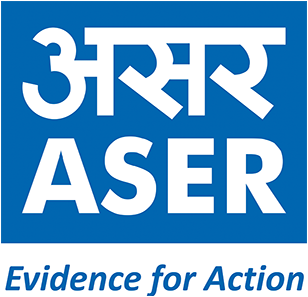
What is ASER?
ASER stands for Annual Status of Education Report. This is an annual citizen-led survey that provides reliable estimates of children’s schooling and learning levels in rural India. See this document for details of coverage each year.
The ‘basic’ ASER survey tracks enrollment for children aged 3-16 and assesses basic reading and arithmetic of children aged 5-16. It was conducted every year from 2005 to 2014 in almost all rural districts of India. Beginning in 2016, an alternate-year model was introduced, where the ‘basic’ ASER survey is conducted in alternate years and in the gap years, a different lens is employed to examine different age groups and/or new aspects of children’s learning.
To access the ASER dataset for research purposes, please write to contact@asercentre.org

Unlike most other large-scale learning assessments, ASER is a household-based rather than school-based survey. This design enables all children to be included – those who have never been to school or have dropped out; those who are in government schools, private schools, religious or other types of schools; as well as those who are absent from school on the day of the assessment.
In the ‘basic’ ASER design, 30 villages are sampled in each rural district from the most recent Census village directory. In each village, 20 randomly selected households are surveyed. This process generates a total of 600 households per district or about 300,000 households for the country as a whole. Approximately 600,000 children aged 3-16 residing in these households are surveyed. See the process documents page for more information.
- Information on schooling status is collected for all children in the age group 3-16 living in sampled households. Children in the age group 5-16 are tested in basic reading and basic arithmetic. The same test is administered to all children, regardless of enrollment status, age or grade. See this document for an overview of ASER sample sizes over the years.
- The highest level of the reading test is a Grade 2-level text. In arithmetic, the highest level is a 3-digit by 1-digit division problem, usually taught in Grade 3 or Grade 4. See the process documents page for the ASER reading and math tools.
- In addition, basic household information is collected every year. In recent years this has included household size, parental education, and some information on household assets. See domains covered in ASER over time for a summary of domains covered each year.
- The largest government primary school in each sampled village is visited and information on school infrastructure, enrollment, attendance, teachers, and fund flows is collected. Since 2010, information on some Right to Education (RTE) indicators has also been collected. See domains covered in ASER over time for a summary of school related information collected and see this document for school coverage each year.
The ASER survey is coordinated by ASER Centre and facilitated by the Pratham network. Around 30,000 volunteers from local partner organisations in each district conduct the survey. Many different kinds of institutions partner with ASER: colleges, universities, NGOs, youth groups, women’s organisations, self-help groups and others. See the partners document for more information.
A district level training workshop is conducted to train volunteers in how to conduct the survey. Thereafter, each team of two surveyors is assigned a sampled village, where they spend two days (usually Saturday and Sunday) conducting the survey. See the process documents page for detailed information.
Three key processes are followed to ensure data quality: training surveyors, monitoring the survey on the field, and rechecking the collected data. These processes are intensively reviewed and strengthened each year. See the process documents page for more details.

